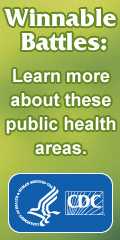September 2013
Did You Know? is a weekly feature from the Office for State, Tribal, Local and Territorial Support to inform your prevention activities. We invite you to read, share, and take action!
View the Current Did You Know?
September 27, 2013
- Each year, about 4,000 infants die suddenly and unexpectedly without an obvious cause of death.
- Improved national reporting and understanding of unexplained infant deaths can inform prevention strategies.
- Nine states now conduct enhanced child death reviews and participate in CDC’s Sudden Unexpected Infant Death Case Registry.
September 20, 2013
- Children with sickle cell disease miss an average of 18 days of school each year due to illness.
- Among people with sickle cell disease, hospital admissions and emergency room visits rise dramatically after age 18, according to data from five states participating in a pilot project.
- You can use CDC's new interactive resource directory to find national agencies, specialty care centers, and community-based organizations in your state that serve people affected by sickle cell disease.
September 13, 2013
- The latest estimates [PDF-1.6MB] show there are about 20 million new sexually transmitted infections (STIs) in the US each year, costing the health-care system nearly $16 billion in direct medical costs.
- About 20 million [PDF-1.6MB] new cases of sexually transmitted diseases (STDs) occur in the United States each year. Left untreated, some STDs can cause severe health consequences.
- CDC recently released an STD Treatment Guidelines mobile app, which helps healthcare providers access diagnostic information and the current STD treatment guidelines.
- Healthcare providers can download the free app on an Apple or Android device.
September 6, 2013
- At least 200,000 deaths from heart disease and stroke each year are preventable.
- We’re all at risk. However, men have a higher risk of death from heart disease and stroke across all races and ethnic groups, and black men are most at risk.
- State and local officials can work with health care systems to monitor national quality indicators and encourage use of health information technology to control high blood pressure.
Did You Know? information and web links are current as of their publication date. They may become outdated over time.
- Page last reviewed: November 9, 2015
- Page last updated: October 14, 2016
- Content source:



 ShareCompartir
ShareCompartir



